Tuesday, 24 November 2015
Sunday, 22 November 2015
Techniques of Editing - Cross cutting and the rest
Write a description of this technique - is this alternative or mainstream?
Cross Cutting - This is where two or more scenes occur at the same time but are in different locations. Parallel editing is used to create mystery and suspense, narrative and pace. This was developed by Edwin S. Porter; he first used cross cutting in The Great Train Robbery in 1903. This technique is mainstream. The purpose of this is storytelling, as it develops drama, combines shots into sequences and manipulates time and space due to the baptism and the murders.
Jump cuts were created in 1896 by Melies he was filming a bus coming out of a tunnel and his camera film jammed when it started filming again it filmed a horse cart going by and when he watched the film a jump cut was created making the bus look like it transformed into the horse cart, he used this in is magical shows to show people disappearing. Jump cuts were usually used to create magically effects durine the 1800s but now in the present days jump cuts are been used to break contuinty and therefore can fall under montage techniques.
Shots changes based on the tempo of music been played so therefore the shots changes according to the tempo of the music. This technique is used to pass time. It was invented by esiestein.
Cross- Cutting
Cross cutting also known as parallel editing, is cutting between two different scenes that are happening at the same time.This technique was created and developed by D.W. Griffith. Cross-Cutting was first used in D.W Griffith's film "After many years" in 1908. The clip below shows an example of cross-cutting being used. The clip is from the film Quantum of Solace. In the scene, A man is being interrogated, the camera then cuts to another scene to show that somebody is approaching in a car. The purpose of Cross-Cutting is to show two important/relevant events in the story that are happening at the same time. Using Cross-Cutting makes the story of a film more interesting for audience. It also allows the audience to be introduced to new characters of the story.
Shot Reverse shot is, involves two characters having a conversation. You would have one character looking at the other, then we would have a reverse shot from that characters point of view. This is also known as continuity editing.The purpose of using short reverse shot to see character face whilst talking instead focusing on one character when talking, by this you can see their emotions whentalking and makes more interesting.
Match on Action is form of continuity editing, it is cutting to shot then cutting to another shot to build up the action. Match on Action is used to get the audience attentions and it also creates drama and excitement. D.W. Griffiths stared to investigate the match on action 180 degree rule and found out some interesting fact on where to place the camera so it does not break the 180 degree rule. it develop by directors trying and finally go it right. Till this day on wards directors have been using match on action and the 180 degree rules sign of continuity editing.
Seamless editing or also known as invisible editing is when the cuts matches with the action. This means that there is no editing involved at all just cuts in between shots so it matches the action of what is happening in the film in a certain scene and continues to have the flow without breaking or ruining it but this certain technique was used by D.W Griffith.
Eye-Line match:
This is when two shots are lined up from a eye line match. This works when you put two cameras in a similar position around the same axis, You would put this in the same position. An eye line shot is also when the camera shows someone looking at something and then then the camera switches to the object or thing the person was looking at. The purpose of this is so that the audience want t know what the character is looking at.
Lev Kuleshov uses an example of an eye-line shot in his Kuleshov effect video. However, the person that was known for discovering this or using this the most was Alfred Hitchcock who used this most frequently in his film.
Motivated:
A motivated edit or motivated cut as it is also known, is when the scene cuts to another scene or object that was not in the previous frame. This is done in a discreet manner so it does not seem confusing to the audience or break the illusion of continuity. i.e. 180 degree rule. The purpose of a motivated edit is usually to build suspense, show a conversation between characters, or flashbacks. This is effective because it lets the audience know what had happened in the past.
Modern Example: The Usual Suspects
In the opening scene to this movie, a motivated edit is used to create a flashback. This means that the camera would cut back to a previous scene or edit that has been showed vaguely or not at all.
The kuleshov effect is when there would a close up but then the second shot can change the meaning completely, the meaning is constructed in our minds.
Point of View shot - This is a technique where it will show the scene from the characters point of view, so you can see the events from their perspective, allowing the audience to feel involved in the film because they can see it as if they are there.
The Point Of View shot is used here, it is done to show the current events taking place from one characters perspective. It is done to see the events from the eyes of the character.
Continuity - A sequence of shots done to entertain the audience, to create a story in a linear sequence. It was invented by D.W Griffiths, through trial as error, as he would try something out and see if it worked. Continuity came from the US, fighting between them and Soviet Russia, who created montage, continuity proved more popular with audiences as it was just done to entertain the audience, unlike montage, which is designed to make the audience think.
Cross Cutting - This is where two or more scenes occur at the same time but are in different locations. Parallel editing is used to create mystery and suspense, narrative and pace. This was developed by Edwin S. Porter; he first used cross cutting in The Great Train Robbery in 1903. This technique is mainstream. The purpose of this is storytelling, as it develops drama, combines shots into sequences and manipulates time and space due to the baptism and the murders.
Jump cuts were created in 1896 by Melies he was filming a bus coming out of a tunnel and his camera film jammed when it started filming again it filmed a horse cart going by and when he watched the film a jump cut was created making the bus look like it transformed into the horse cart, he used this in is magical shows to show people disappearing. Jump cuts were usually used to create magically effects durine the 1800s but now in the present days jump cuts are been used to break contuinty and therefore can fall under montage techniques.
Shots changes based on the tempo of music been played so therefore the shots changes according to the tempo of the music. This technique is used to pass time. It was invented by esiestein.
Cross- Cutting
Cross cutting also known as parallel editing, is cutting between two different scenes that are happening at the same time.This technique was created and developed by D.W. Griffith. Cross-Cutting was first used in D.W Griffith's film "After many years" in 1908. The clip below shows an example of cross-cutting being used. The clip is from the film Quantum of Solace. In the scene, A man is being interrogated, the camera then cuts to another scene to show that somebody is approaching in a car. The purpose of Cross-Cutting is to show two important/relevant events in the story that are happening at the same time. Using Cross-Cutting makes the story of a film more interesting for audience. It also allows the audience to be introduced to new characters of the story.
Shot Reverse shot is, involves two characters having a conversation. You would have one character looking at the other, then we would have a reverse shot from that characters point of view. This is also known as continuity editing.The purpose of using short reverse shot to see character face whilst talking instead focusing on one character when talking, by this you can see their emotions whentalking and makes more interesting.
Match on Action is form of continuity editing, it is cutting to shot then cutting to another shot to build up the action. Match on Action is used to get the audience attentions and it also creates drama and excitement. D.W. Griffiths stared to investigate the match on action 180 degree rule and found out some interesting fact on where to place the camera so it does not break the 180 degree rule. it develop by directors trying and finally go it right. Till this day on wards directors have been using match on action and the 180 degree rules sign of continuity editing.
Seamless editing or also known as invisible editing is when the cuts matches with the action. This means that there is no editing involved at all just cuts in between shots so it matches the action of what is happening in the film in a certain scene and continues to have the flow without breaking or ruining it but this certain technique was used by D.W Griffith.
Eye-Line match:
This is when two shots are lined up from a eye line match. This works when you put two cameras in a similar position around the same axis, You would put this in the same position. An eye line shot is also when the camera shows someone looking at something and then then the camera switches to the object or thing the person was looking at. The purpose of this is so that the audience want t know what the character is looking at.
Lev Kuleshov uses an example of an eye-line shot in his Kuleshov effect video. However, the person that was known for discovering this or using this the most was Alfred Hitchcock who used this most frequently in his film.
Motivated:
A motivated edit or motivated cut as it is also known, is when the scene cuts to another scene or object that was not in the previous frame. This is done in a discreet manner so it does not seem confusing to the audience or break the illusion of continuity. i.e. 180 degree rule. The purpose of a motivated edit is usually to build suspense, show a conversation between characters, or flashbacks. This is effective because it lets the audience know what had happened in the past.
Modern Example: The Usual Suspects
In the opening scene to this movie, a motivated edit is used to create a flashback. This means that the camera would cut back to a previous scene or edit that has been showed vaguely or not at all.
The kuleshov effect is when there would a close up but then the second shot can change the meaning completely, the meaning is constructed in our minds.
Point of View shot - This is a technique where it will show the scene from the characters point of view, so you can see the events from their perspective, allowing the audience to feel involved in the film because they can see it as if they are there.
The Point Of View shot is used here, it is done to show the current events taking place from one characters perspective. It is done to see the events from the eyes of the character.
Continuity - A sequence of shots done to entertain the audience, to create a story in a linear sequence. It was invented by D.W Griffiths, through trial as error, as he would try something out and see if it worked. Continuity came from the US, fighting between them and Soviet Russia, who created montage, continuity proved more popular with audiences as it was just done to entertain the audience, unlike montage, which is designed to make the audience think.
Monday, 16 November 2015
Parrell Editing and Point of view
Portfolio of Editing Techniques - with annotations on how, why it is used and when it was developed/by whom.
Parallel editing - Parallel editing is also known as cross cutting. This is where two or more scenes occur at the same time but are in different locations. Parallel editing is used to create mystery and suspense, narrative and pace. This was developed by Edwin S. Porter; he first used parallel editing in The Great Train Robbery in 1903.
POV -
It is usually established by being positioned between a shot of a character looking at something, and a shot showing the character's reaction. It is used to show what a character is seeing. Alfred Hitchcock used most of the POV shot in his 1954 film, Rear Window. In Rear Window, it is shown that POV Shot is used to show what the character is looking at, (as you can see the character is looking outside and the houses opposite them.)
Parallel editing - Parallel editing is also known as cross cutting. This is where two or more scenes occur at the same time but are in different locations. Parallel editing is used to create mystery and suspense, narrative and pace. This was developed by Edwin S. Porter; he first used parallel editing in The Great Train Robbery in 1903.
POV -
It is usually established by being positioned between a shot of a character looking at something, and a shot showing the character's reaction. It is used to show what a character is seeing. Alfred Hitchcock used most of the POV shot in his 1954 film, Rear Window. In Rear Window, it is shown that POV Shot is used to show what the character is looking at, (as you can see the character is looking outside and the houses opposite them.)
Friday, 6 November 2015
Technical Analysis 3 - The Rattler
The Rattler is a short horror film that has a number of events that occur during the 5 minute clip.
Narrative & Format
This short film is edited in a linear way to show the events that happen in this short film to
Genre Conventions are key in this short film as the costumes in this film are the main focus. Also, props are important because
As you can see in this screenshot, there are a range of props such as, the wine glass, art pad, and computer. These are all important in the film because they all have key roles. The computer is the most important prop of them all because the majority of the action takes place on it.
In this screenshot it shows that there is an incoming video call from a unknown caller. This gives suspense to the audience and character as we do not know who is calling at that moment of time.
Lighting
Naturalistic lighting is the only lighting that is used in this short film because this is filmed in a house where there are different types of lighting due to which room the character is in. In this screenshot it shows that there is a bright light that is from her computer screen. Naturalistic lighting makes it more realistic.This is clearly low-key lighting by the computer and the lighting changes.
Editing
This screenshot is a close up as it shows a handle. This handle is important because the 'Rattler' is trying to get into the house. This creates fear as the character is scared for her life.
This is also a close up as it shows the broken door knob and the character's feet. This also creates fear because the Rattler is behind the door she is trapped behind.
Finally, this is also a close-up as we get to see the Rattler's face through a small hole. This creates terror and fright because the camera switches from the lady to the hole quickly which makes people jump.
Sound
There are mainly diegetic sounds as the majority of the sounds both audience and characters can hear.
Technical Analysis 2 - 2AM: The Smiling Man
2AM: The Smiling Man is a short thriller/horror film which is about an feared character and a extraordinary individual. This short film is shot on the street at late hours of the night.
Narrative & Format
The Smiling Man is linear as it shows all of the events in order, it has beginning, middle and end.
Genre conventions are very important in this short film as location is the most important as this is shot outside rather than inside. Costume and props is not as important due to the main focus of the film is on the location and characters.
Locations -
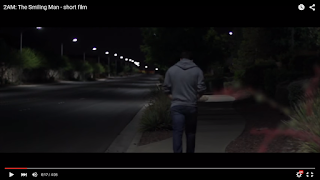 In this screenshot, it shows that this short film is based on a empty, quiet street. This is the main focus as this is where all of the activities that took place were shot.
In this screenshot, it shows that this short film is based on a empty, quiet street. This is the main focus as this is where all of the activities that took place were shot.Lighting -
Naturalistic lighting is the most common lighting that is used in this short film because as there are a high street lights on a wide stretch of the road, there is no need for extra lighting to be used to reveal character's faces. High Key and Low Key lighting was not used as naturalistic lighting is used to make it more realistic.
In this screenshot, this shows that the lighting from the street lamps give the street a natural light as high key lighting is not needed for this time of day.
Coverage Shots -
Depth of Field was commonly used in this short film as the main focuses of the film was on both characters and not the street.
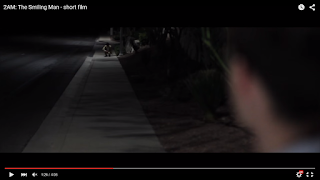 This screenshot shes the character and creepy individual in one shot but one character is blurred out so the main focus can be on the creepy individual.
This screenshot shes the character and creepy individual in one shot but one character is blurred out so the main focus can be on the creepy individual.This shot shows the emotion in the character's face while the depth of field shot is being used. This implicates that the background is not important as the audience is only focusing on the character's face.
Framing and Composition -
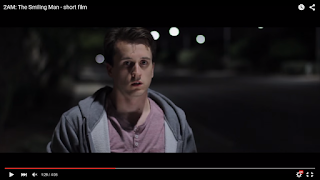 Depth adds interest into the shot. In this case, it shows the characters face and in the background is the blurred street lights and objects. This is not important because this frame is used to show the character's facial expression.
Depth adds interest into the shot. In this case, it shows the characters face and in the background is the blurred street lights and objects. This is not important because this frame is used to show the character's facial expression.Editing -
Jump cuts are the most common shots to be used in this short film as when the character starts to run away there are three different shots that shows him running away from the creepy character.
This screenshot shows the character running away as the camera is set up from the back to show that the creepy character is running behind him.
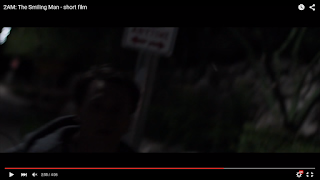
This shot was filmed in the front of the character. As he ran, the camera followed him. This is to put the audience in the character's perspective of fear.
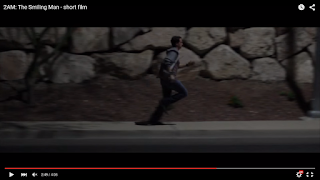
This shot was filmed from the other side of the road as it shows that the character is still running away. This is also a wide shot as it shows parts of the background of where he is running to alert viewers.
This is a over the shoulder shot because it shows the creepy individual watching the loner as he crosses the road because he is in fear of it trying to attack him.
 |
 |
This short film uses continuity techniques such as 180 degree rule and shot reverse shot to show relationship between characters
The editing of this short film also uses pace to keep the audience engaged as if it was a slow paced clip, it wouldn't have much viewers as horror films consist of fast pace and movements.
Sound -
There are limited sounds in this short film. Diegetic sounds such as the character's voice, footsteps, wind and sound of distant cars are heard by both the characters and audience. Non-Diegetic sounds such as the creepy music is not heard by the characters and only the audience to bring secrecy.
Sunday, 1 November 2015
Technical Analysis - 1 Porcelain Rising
Porcelain Rising is a Horror Short film that is set in a family home with a father and daughter. The action of the film is mainly shot in the daughter's bedroom.
Narrative & Format
The narrative of Porcelain Rising is linear because all of the events that are happening in this short film, they are in order which shoes that it is linear. This is a realist narrative as it shows that dolls come to life. It shows that the 'doll' is the same height as the character but in reality dolls are not human. This shows that porcelain rising is realist due to the fact that the events that occur in this short film makes it realistic so the audience can feel emotion as they think it may happen in real life.
The format of this short film is a single drama as there won't be a second part to this because it ends with a cliff hanger. ("what are you doing with that knife?")
The effects of Genre conventions is that costumes location and props are very important when it comes to filming as they are one of the few main objects that catch the audience's eye.
Costume -
Costume is important in this short film because there are a number of scenes where characters outfits stand out and have a certain meaning.
For example, this screenshot shows that the character has been stabbed (because she is being sacrificed). This is important because there are a number of blood stains on her clothing. The blood represents danger because it is red and is always shown in thriller and horrors.
Another example is this screenshot, as it shows that this character is dangerous because of the mask that they are wearing represents that they are the murderer.
Locations -
Locations is also an important factor in this short film because there are two main areas in the family house that were filmed. The areas were: bedroom and kitchen; the bedroom was the main focus in the short film because the majority of what was filmed was shot in the bedroom.
 This is one of the locations, which was the kitchen.
This is one of the locations, which was the kitchen.And the last location is the bedroom, where all of the action took place.
Props -
Lastly, props were important because they had significant meanings in the short film. I will now explain four examples and why they are significant.
 These props are significant in this short film because it hides a certain identity and character which is the doll with the mask on. This character may be portrayed as a doll to confuse viewers to think further on during the film the character is a doll, when it is actually a human.
These props are significant in this short film because it hides a certain identity and character which is the doll with the mask on. This character may be portrayed as a doll to confuse viewers to think further on during the film the character is a doll, when it is actually a human.
A second example is of the father dialing a number on his phone. This is important because he is away from the action in the bedroom and has no clue on what is going on.

This is one of the most important props in the short film because it has a big role and is portrayed as a doll when it is actually a human.
 As you can see, this character is holding a knife in her hand which symbolizes that she is about to murder someone (which is the father). This gives a mystery because this is how the film ends, with a cliff hanger.
As you can see, this character is holding a knife in her hand which symbolizes that she is about to murder someone (which is the father). This gives a mystery because this is how the film ends, with a cliff hanger.Lighting and Colours
High key and Low Key lighting are the main types of lighting that is used in this short film. I have collected a range of screenshots to show and explain why they have been used.
Low Key Lighting -
Low key lighting gives a dramatic and mysterious mood when it comes to horror and thrillers. This is to create suspense and mystery as it creates a dull and emotional atmosphere.
 This screenshot shows that low key lighting has been used to represent that she has just been awoken as there may be something lurking in the dark. This creates mystery because we are unaware of what is happening.
This screenshot shows that low key lighting has been used to represent that she has just been awoken as there may be something lurking in the dark. This creates mystery because we are unaware of what is happening.
This screenshot also shows low key lighting as this character is hiding under her bed. Chiaroscuro has been used in this screenshot because it creates the volume and depth between the character's face.
High Key Lighting -
High Key Lighting gives a optimistic and positive mood as it is the opposite to Low Key Lighting; as the contrast has been compressed. But in this case, the high key lighting gives shock and creates more contrasting shots when it comes to making horrors.
 In this screenshot it shows that lighting is key in this part of the film because as the lighting strikes, the face of the doll appears. This creates fear and shock because the doll was placed in the closed cupboard but it escaped some how. It also shows that in this case, high key lighting does not create a upbeat mood because this is a horror.
In this screenshot it shows that lighting is key in this part of the film because as the lighting strikes, the face of the doll appears. This creates fear and shock because the doll was placed in the closed cupboard but it escaped some how. It also shows that in this case, high key lighting does not create a upbeat mood because this is a horror.Naturalistic Lighting -
Naturalistic lighting was not used in this short film as it was filmed at night. However there are a number of shots that have natural lighting that beams inside from the night sky.

In this screenshot it shows how the street lights from outside shone its way into the kitchen. This implicates that as natural lighting has been used, it makes it realistic. Also, the use of jump cuts are used to break continuity to show insecurity and to show that something supernatural is going on. (2:48)
Coverage Shots
Angles -
Angles are very critical in films because they indicate mood and tension.

Editing
Editing is very important when it comes to films because this is the final step to completion. Shots such as , match on action and jump cuts were used in this short film; and the most common shot which was used was match on action.
 Match on action and close ups have been used a number of times in this short film because it reveals the character's facial expressions and as it switches camera angles at a fast pace, it then shows what the doll has done to the character.
Match on action and close ups have been used a number of times in this short film because it reveals the character's facial expressions and as it switches camera angles at a fast pace, it then shows what the doll has done to the character.

This over the shoulder shot has been used to show one character's facial expression by only showing one face, as the camera is placed at the side of the character and sets the position of two characters.

This wide shot has been used in this short film to show exactly what is happening between these two characters. What is being shown is that the girl is being attacked by the live doll. This is to create shock and fear because now the audience know that the doll is real.
Sounds
Sounds are very important in films because there are four main areas such as Diegetic, Non Diegetic, Soundtrack and Effects.
The first area I will discuss is Diegetic sounds. Sounds such as the voices of the characters, rain, thunder, screams, children's laughs. Diegetic sounds are used to tell a visual story; these are the sounds that the characters and audience can hear.
Secondly, is Non-Diegetic sounds. Sounds such as the scary music and sound effects can only be heard by the audience to create mystery and fear.
Subscribe to:
Comments (Atom)











